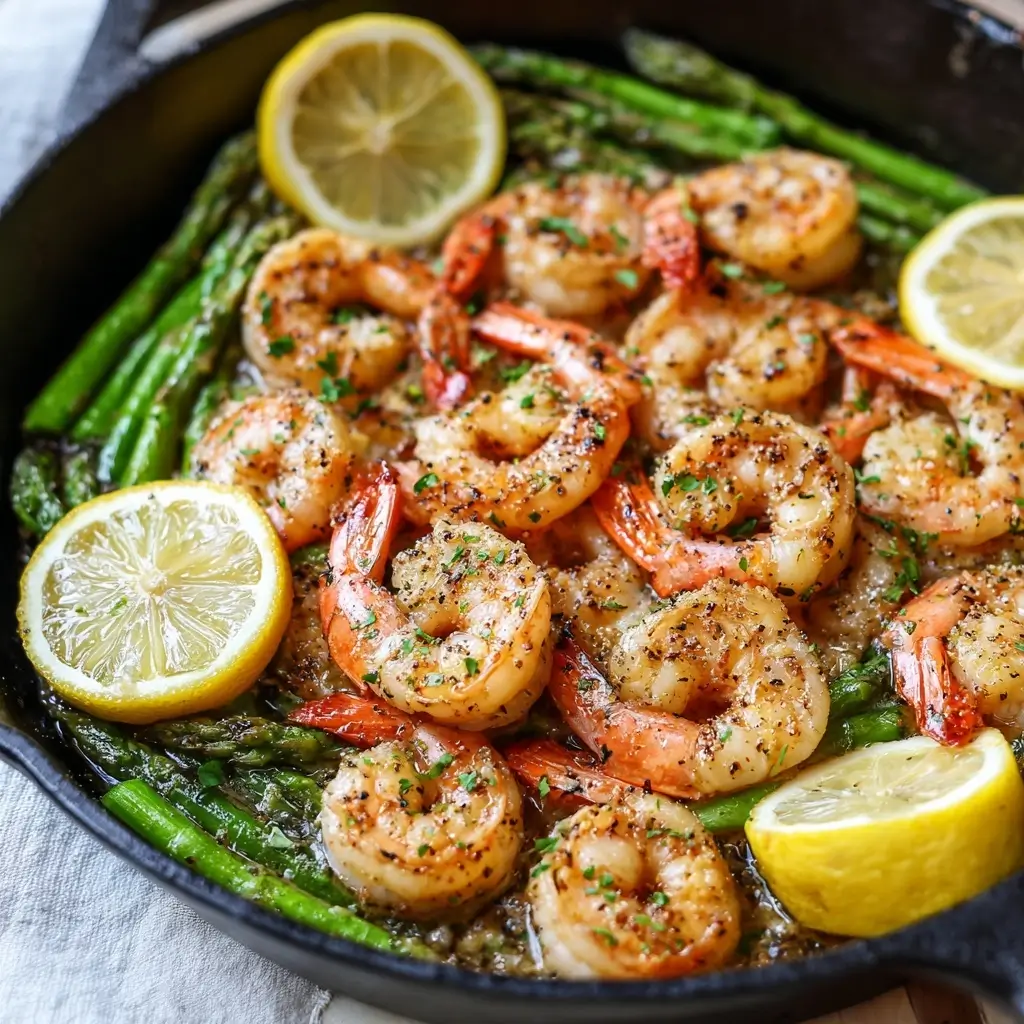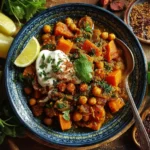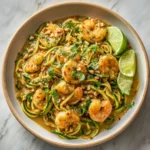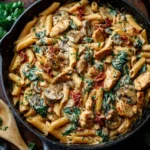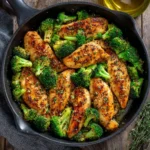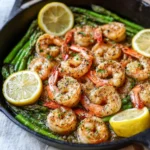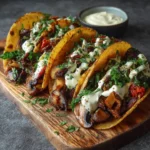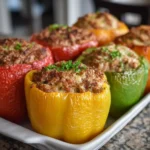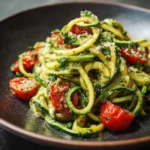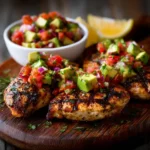Introduction
Welcome to a culinary delight that combines elegance, simplicity, and bold flavor in one sizzling skillet—Lemon Garlic Butter Shrimp & Asparagus Skillet. This dish is the perfect harmony of succulent shrimp, tender-crisp asparagus, and a vibrant sauce infused with garlic, lemon, and rich butter. Ideal for weeknight dinners yet refined enough to serve at dinner parties, this one-pan wonder saves time on cleanup while maximizing taste. Whether you’re cooking for yourself or sharing with loved ones, this recipe brings restaurant-quality flavor straight to your kitchen table with minimal effort and maximum satisfaction.
The History
The roots of combining seafood with vegetables in a single pan can be traced back to coastal Mediterranean cuisines, where fresh catches were often sautéed with seasonal produce, olive oil, garlic, and citrus. Countries like Italy, Spain, and Greece have long celebrated dishes featuring shrimp or other shellfish cooked quickly over high heat with aromatic ingredients. The addition of lemon and butter reflects French influence, particularly from techniques used in beurre blanc and à la provençale preparations. Over time, American home cooks adapted these European traditions, blending them with accessible ingredients to create fast, flavorful meals. The Lemon Garlic Butter Shrimp & Asparagus Skillet emerged as a modern fusion of these culinary heritages—simple, healthy, and deeply satisfying—a testament to how global flavors can come together in a single, delicious dish.
Ingredients Breakdown
Every ingredient in this recipe plays a crucial role in building layers of flavor, texture, and nutrition:
- Shrimp: Large or jumbo shrimp (peeled and deveined) are ideal for their meaty texture and quick cooking time. They absorb the garlicky butter sauce beautifully.
- Asparagus: Fresh asparagus spears add a crisp-tender bite and earthy-sweet flavor. Choose firm, bright green stalks with tightly closed tips.
- Butter: Unsalted butter forms the luxurious base of the sauce, providing richness and helping to brown the shrimp perfectly.
- Olive Oil: Combined with butter, it raises the smoke point and adds a fruity depth to the dish.
- Garlic: Freshly minced garlic is essential—it delivers a pungent aroma and savory backbone when sautéed gently in fat.
- Lemon: Both zest and juice contribute brightness and acidity, cutting through the richness of the butter and enhancing the natural sweetness of the shrimp.
- White Wine (optional): Adds complexity and a subtle tang; helps deglaze the pan and lift flavorful browned bits.
- Salt & Black Pepper: For seasoning at every stage to enhance overall flavor.
- Red Pepper Flakes: A pinch introduces gentle heat that balances the citrus and butter.
- Fresh Herbs (parsley, dill, or thyme): Used as garnish, they bring freshness and color, finishing the dish with an aromatic lift.
Step-by-Step Recipe
- Prep Ingredients: Peel and devein the shrimp, pat them dry with paper towels, and season lightly with salt and pepper. Trim the woody ends off the asparagus by snapping or cutting just below the tough part. Cut into 2-inch pieces if desired. Mince the garlic, zest and juice the lemon, and chop the fresh herbs.
- Heat the Skillet: Place a large oven-safe or heavy-bottomed skillet (such as cast iron or stainless steel) over medium-high heat. Add half the butter and the olive oil, swirling to coat the pan evenly.
- Sear the Shrimp: Once the butter is melted and slightly foamy, add the shrimp in a single layer. Cook for 1–2 minutes per side until pink and just opaque. Avoid overcrowding to ensure proper browning. Remove the shrimp to a plate and set aside.
- Cook the Asparagus: In the same skillet, add the asparagus. Sauté for 4–5 minutes, stirring occasionally, until bright green and tender-crisp. If needed, splash a tablespoon of water and cover briefly to steam.
- Sauté the Garlic: Reduce heat to medium. Add the remaining butter and minced garlic. Stir constantly for about 30 seconds to 1 minute—do not let it burn, or it will turn bitter.
- Deglaze (Optional): Pour in ¼ cup of dry white wine (or substitute with chicken broth or vegetable broth). Use a wooden spoon to scrape up any browned bits from the bottom of the pan. Simmer for 1–2 minutes until slightly reduced.
- Combine Everything: Return the shrimp to the skillet. Add lemon zest and juice. Toss everything together gently to coat in the sauce. Cook for another 1–2 minutes just to reheat the shrimp and blend the flavors.
- Finish and Serve: Sprinkle with red pepper flakes (to taste), and stir in most of the chopped parsley or dill, reserving some for garnish. Taste and adjust seasoning with more salt, pepper, or lemon juice if needed.
- Garnish and Plate: Transfer to a serving platter or divide among plates. Garnish with extra herbs, a lemon wedge, and freshly cracked black pepper.
Tips
- Dry Shrimp = Better Browning: Always pat shrimp dry before cooking. Moisture prevents searing and leads to steaming instead of caramelization.
- Don’t Overcook Shrimp: Shrimp cook very quickly and become rubbery if left too long. Remove them from heat as soon as they turn opaque.
- Use Fresh Garlic: Pre-minced jarred garlic lacks flavor and may have additives. Freshly minced garlic makes a noticeable difference.
- Balance Acidity: Start with half the lemon juice, then taste and add more as needed. Too much lemon can overpower delicate shrimp.
- Uniform Asparagus Size: Try to select asparagus spears of similar thickness so they cook evenly.
- Skillet Choice Matters: A good-quality skillet ensures even heating. Cast iron retains heat well and gives excellent sear marks.
- Rest Before Serving: Let the dish sit for 1–2 minutes after cooking to allow flavors to meld.
- Serve Immediately: This dish is best enjoyed hot off the stove when textures and aromas are at their peak.
Variations and Customizations
This versatile recipe welcomes creative tweaks to suit different tastes, dietary needs, or pantry availability:
- Protein Swap: Replace shrimp with scallops, chicken breast strips, or even tofu for a vegetarian version.
- Veggie Additions: Enhance the skillet with sliced bell peppers, cherry tomatoes, zucchini, spinach, or mushrooms. Add delicate greens like baby spinach during the last minute of cooking.
- Dairy-Free Option: Substitute butter with vegan butter or use all olive oil. Coconut oil can work but will alter the flavor profile slightly.
- Gluten-Free Friendly: This recipe is naturally gluten-free—just ensure all added ingredients (like broth or wine) are certified GF if necessary.
- Creamy Version: Stir in 2–3 tablespoons of heavy cream, crème fraîche, or Greek yogurt at the end for a richer, silkier sauce.
- Herb Variations: Try tarragon for a French twist, basil for Italian flair, or chives for mild onion notes.
- Spice It Up: Increase red pepper flakes or add a dash of smoked paprika or cayenne for deeper heat.
- Lemon Alternatives: Use lime or orange for a different citrus note—especially great with cilantro instead of parsley.
- Wine-Free Version: Skip the wine and use low-sodium broth with a splash of apple cider vinegar or white wine vinegar for acidity.
- Grilled Option: Thread shrimp and asparagus onto skewers and grill for a smoky flavor. Baste with warm lemon garlic butter while grilling.
Health Considerations and Nutritional Value
Lemon Garlic Butter Shrimp & Asparagus Skillet isn’t just delicious—it’s also packed with nutritional benefits when prepared mindfully:
- Low in Carbohydrates: Naturally low-carb and keto-friendly, making it suitable for those managing blood sugar or following ketogenic diets.
- High-Quality Protein: Shrimp provides lean protein with all essential amino acids, supporting muscle maintenance and satiety.
- Rich in Antioxidants: Garlic contains allicin, known for immune-boosting and anti-inflammatory properties.
- Vitamin C Boost: Lemon juice contributes vitamin C, which supports collagen production and enhances iron absorption.
- Fiber and Folate from Asparagus: Asparagus is high in dietary fiber, folate, and vitamins A, C, E, and K. It also contains glutathione, a powerful antioxidant.
- Heart-Healthy Fats: Olive oil provides monounsaturated fats linked to improved heart health and reduced inflammation.
- Cholesterol Awareness: Shrimp do contain cholesterol, but recent research suggests dietary cholesterol has less impact on blood cholesterol than once thought. For most people, moderate consumption is fine.
- Sodium Control: You can easily reduce sodium by using unsalted butter, limiting added salt, and choosing low-sodium broths.
- Balanced Meal Tip: Serve with quinoa, brown rice, or crusty whole-grain bread to add complex carbs and make it a complete meal.
Note: While butter adds richness, portion control helps maintain heart-healthy balance. Using a mix of olive oil and butter reduces saturated fat without sacrificing flavor.
Ingredients
- 1 pound (450g) large or jumbo shrimp, peeled and deveined
- 1 bunch (about 1 lb / 450g) fresh asparagus, trimmed and cut into 2-inch pieces
- 4 tablespoons unsalted butter, divided
- 2 tablespoons olive oil
- 4 cloves garlic, minced
- Zest and juice of 1 large lemon (about 3 tbsp juice)
- ¼ cup dry white wine (e.g., Sauvignon Blanc or Pinot Grigio) – optional
- ½ teaspoon red pepper flakes (adjust to taste)
- Salt and freshly ground black pepper, to taste
- ¼ cup fresh parsley, finely chopped (or substitute dill or thyme)
- Lemon wedges, for serving
Directions
- Pat the shrimp dry with paper towels and season lightly with salt and pepper. Set aside.
- Trim the asparagus and cut into uniform pieces. Mince the garlic, zest and juice the lemon, and chop the herbs.
- Heat a large skillet over medium-high heat. Add 2 tablespoons of butter and 2 tablespoons of olive oil.
- Once the butter is melted and shimmering, add the shrimp in a single layer. Sear for 1–2 minutes per side until pink and opaque. Remove and set aside.
- In the same pan, add the asparagus. Cook for 4–5 minutes, stirring occasionally, until bright green and tender-crisp.
- Reduce heat to medium. Add the remaining 2 tablespoons of butter. Once melted, stir in the minced garlic and sauté for 30 seconds–1 minute until fragrant (do not burn).
- (Optional) Pour in the white wine and simmer for 1–2 minutes until reduced by half, scraping up any browned bits.
- Return the shrimp to the skillet. Add lemon zest, lemon juice, and red pepper flakes. Toss gently to combine.
- Cook for another 1–2 minutes to heat through. Season with salt and pepper to taste.
- Remove from heat. Stir in most of the chopped parsley or dill, reserving some for garnish.
- Transfer to a serving dish, garnish with extra herbs and lemon wedges, and serve immediately.
FAQ
Can I use frozen shrimp?
Yes, but thaw them properly in the refrigerator overnight or under cold running water. Pat dry thoroughly before cooking to avoid excess moisture.
Is it safe to eat shrimp every day?
For most people, eating shrimp several times a week is safe and nutritious. However, those with shellfish allergies should avoid it entirely. Consult your doctor if you have specific health concerns.
Can I make this ahead of time?
It’s best served fresh, but you can prep ingredients in advance. Store cut asparagus, minced garlic, and seasoned shrimp separately in airtight containers for up to 24 hours.
What kind of white wine should I use?
Choose a dry, crisp white wine you’d enjoy drinking—Sauvignon Blanc, Pinot Grigio, or unoaked Chardonnay work well. Avoid sweet wines.
Can I cook this in a non-stick pan?
Yes, though stainless steel or cast iron gives better browning. Be gentle with utensils to protect the coating.
How do I know when shrimp are done?
Shrimp are cooked when they turn opaque and form a “C” shape. Overcooked shrimp curl tightly into an “O” and become tough.
Can I add pasta to this dish?
Absolutely! Toss with fettuccine, linguine, or orzo for a hearty meal. Reserve some pasta water to thin the sauce if needed.
Is this recipe dairy-free?
Not as written, but you can substitute butter with vegan butter or increase olive oil for a dairy-free version.
Summary
Lemon Garlic Butter Shrimp & Asparagus Skillet is a quick, elegant one-pan meal bursting with bright citrus, savory garlic, and tender seafood paired with crisp asparagus. Packed with flavor and nutrients, it’s perfect for busy weeknights or impressing guests with minimal effort.
